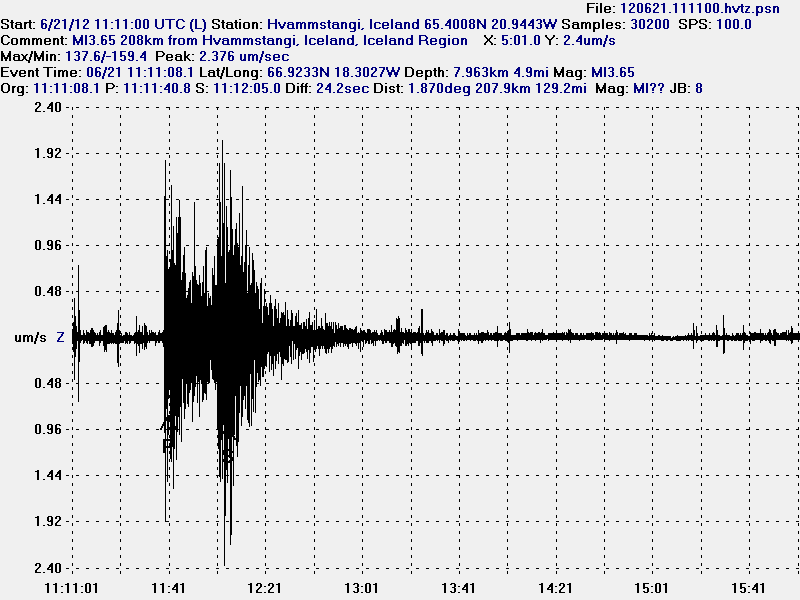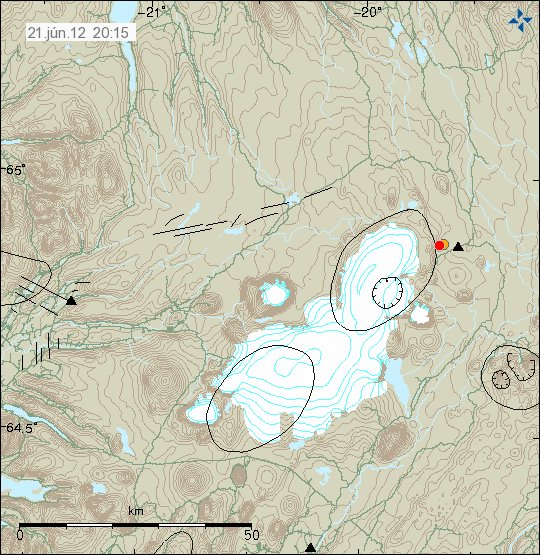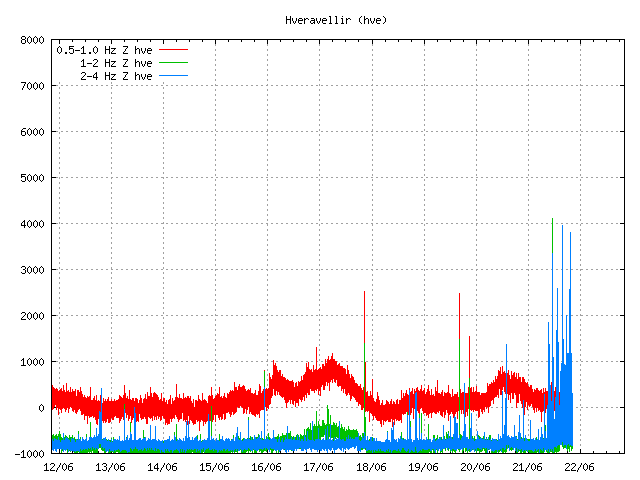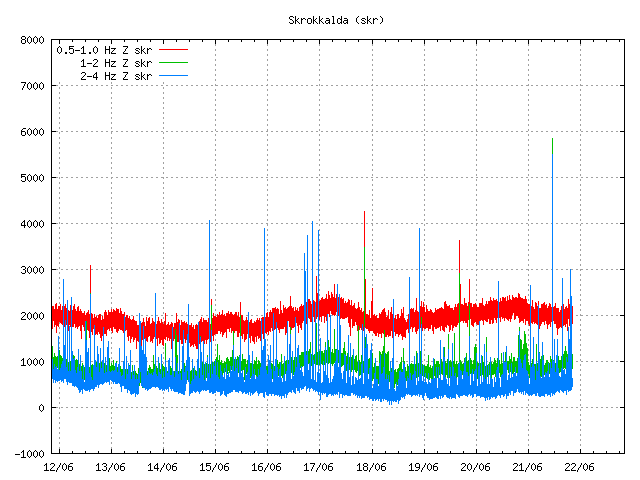It has been a bit busy day earthquake wise in Iceland. But there has been more activity today then in past few weeks in Iceland. But it has been really quiet for a long time now in Iceland. But let’s start with the largest earthquake of the day.
Kolbeinsey Ridge
Today at 11:11 UTC there was an earthquake with the magnitude of ML3.65. This earthquake was not felt since it was more then 100 km away from nearest human population in Iceland. The earthquake took place on Kolbeinsey Ridge. It last erupted in the year 1755. No known eruption is known in this area since then. My geophone network did record this earthquake properly. The signal was strongest at my Hvammstangi geophone station. But it was also recorded on my Heklubyggð geophone station. On other geophone stations. The signal was too weak to be properly detected by my geophone.

The ML3.65 magnitude earthquake as it was recorded on my Hvammstangi geophone. This image is released under Creative Commons licence. Please see the CC Licence page for more details.

The ML3.65 magnitude earthquake as it was recorded on my Heklubyggð geophone. It is filtered at 1Hz. This image is released under Creative Commons licence. Please see the CC Licence page for more details.

The location of the earthquake. Copyright of this picture belongs to Iceland Meteorological Office.
Hveravellir geothermal area
There is an earthquake swarm ongoing (or it might be over. I have no good way to know that currently) at Hveravellir geothermal area. I only know there is an earthquake swarm there because of the tremor recording on Hveravellir geothermal area. But only two earthquakes have been large enough to appear on earthquake map on IMO web page.

The two earthquakes that did appear on IMO earthquake map. Copyright of this picture belongs to Iceland Meteorological Office.

However, Hveravellir SIL station did show that more was going on then did appear on the earthquake map. Most of this earthquakes are too small to appear automatic on the earthquake list. Some might even be too weak to be properly located by the SIL network. Copyright of this picture belongs to Iceland Meteorological Office.

Some of this activity did also appear on Skrokkalda SIL station I think. Copyright of this picture belongs to Iceland Meteorological Office.
Katla volcano
Katla volcano did have an new earthquake swarm during the night. This earthquake swarm had around 30 or so earthquakes. Most of them where located almost in the central caldrea. This type of swarm activity has now been ongoing since end of April, when it started rather sharply with an earthquake swarm. Since then it has had many earthquake swarm. But the current rate of earthquake swarm is around 1 to 3 earthquake swarm pr. Week. Normally they are in an new area inside the Katla volcano caldera.
My geophone station at Skeiðflöt records most of the earthquakes if the background noise is not too high during that time.

The earthquake activity in Katla volcano last night. Copyright of this picture belongs to Iceland Meteorological Office.
So far. This is just normal earthquake activity. It does not signal any chance of eruption activity so far. But this earthquake pattern is interesting. What it means is a different matter. So far, nobody knows for sure at this point in time. This activity seems to change hydrothermal activity inside Katla volcano caldera. This has also created minor glacier floods from Katla volcano caldera. But the flood have been seen on instruments that record water conditions in Múlakvíls glacier river. Glacier floods are marked by higher conductivity of the water, darker color and stronger sulfur smell (rotten egg smell). What happens next in Katla volcano is anyone guess. As Katla volcano has proven to be unpredictable volcano.

What is the differenve between an EQ’s P and S wave? Thanks for the good work Jón. I’ve been following you now for a year and it’s so intresting. People yesterday critizicing that you are never sure of what EQ means don’t know behaviour of volcans and the earth in Iceland. Keep up the good work!!!
These should help you –
http://www.youtube.com/watch?v=gl4FvHKzAlU&feature=related
http://www.geo.mtu.edu/UPSeis/waves.html
New earthquake swarm started in Katla volcano during the night. It is ongoing at current time.
Still normal activity?
It is rather quiet at the moment. The earthquake swarm at Hveravellir is slowing down it seems. Also the earthquake swarm in Katla volcano seems to be dropping off now.
Some focused activity under El Hierro the past few days, the first time in a while.
http://www.01.ign.es/ign/resources/volcanologia/jpg/Eventos_HIERRO_us.jpg
It strikes me as ominous Katla has been bubbling away as it has these past couple of years. Is there a correlation between this kind of behavior and eventual volume of material in an eruption in other volcanoes? As in a magma chamber that takes a long time to fill?
I don’t think anyone really knows the answer to this question.
Some data on Katla –
http://www.volcanodiscovery.com/katla.html
The idea of magma chambers filling up and remaining as magma (as opposed to cooling and hardening), is open to great conjecture as there are a couple of schools of thought. One being that a mantle plume exists beneath Iceland and sustains these temperatures capable of maintining magma in molten state, or that the heat is generated by tectonic movement.
However, both theories have failings. The instrumentation monitoring Iceland and the ocean around it, do not support the mantle plume theory – that along with the fact that the plume would have had to migrate from its original locality over several millenia. The tectonic theory fails to an extent since there are other areas on earth with very great tectonic movement – yet no volcanoes.
Perhaps that is down to whether the faults are convergent or divergent or in subduction zones – or perhaps the whole problem is that Iceland has both? There is no doubt there is a lot of magma moving around along the faults throughout Iceland whether dike intrusions or magam chambers being fed from a plume.
There is a great deal of material on the web about Iceland, but the deeper you delve the more complex it becomes. This is a good site for a read on the matter –
http://www.mantleplumes.org/Iceland1.html
thanks!
Thank you Jon – a very interesting paper that explains a lot!
Clive
I have updated my helicorder page (webicorder). I have added few new links to web cameras. Done some minor updates to the web pages and so on.
http://www.simnet.is/jonfr500/earthquake/
Why the use of the ‘do imperative’ instead of the past simple?
eg “Katla volcano did have an new earthquake swarm during the night”
The past simple would be “Katla had………”
Your English is really good, so is this just ‘Jon’s English’ which is ok if you want, or just mistake?
Keep up keeping up!
I do use English like Jon. I did see your comment and just want to say that in Somerset we do tend to use do and did quite a lot. That is my dialect and I don’t think that I want to change how I speak. Jon’s English is better than my Icelandic. 😀
hiya jon and all,
just right now another series at katla
http://en.vedur.is/earthquakes-and-volcanism/earthquakes/myrdalsjokull/
I see all the latest earthquakes Katla almost on the surface, could be ice movements?.
What I see is that a few days the swarm went up a little north, inside the boiler
Translation by Mr Google
regards
Current earthquakes are not ice movements. While ice-quakes sometimes are registered. They have a lot less energy then earthquakes that happen in the crust. So current earthquakes are made by crust breaking, due to magma or hydro-thermal activity inside Katla volcano caldera.